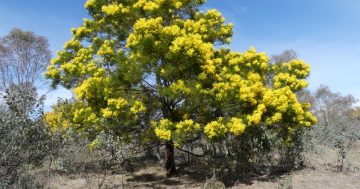
From left: Dr Andrzej Kilian, director of Diversity Arrays Technology; Professor Geoff Crisp, University of Canberra’s acting vice-chancellor; Professor Owen Atkin, director of the Centre for Entrepreneurial Agri-Technology at ANU; and Ash Balaretnaraja from the ACT Government. Photo: Supplied.
A Canberra biotechnology company that specialises in the genetic screening of plants and animals is behind a $3 million investment in technology that will turbocharge the understanding of events such as bushfires and climate change on flora and fauna by accessing data from around the world that would otherwise be lost.
The investment is a collaboration between company Diversity Arrays Technology (DArT), the University of Canberra, Australian National University and the ACT Government. It will allow researchers and scientists to access genetic data that will help them understand the impact of global events on plants and animals.
The project will develop a big data platform powered by DNA information from thousands of species of flora and fauna that will be accessible to users around the world to track the impact of events such as bushfires and climate change, and assist with the management of our natural ecosystems.
DArT will invest $3 million to develop the platform, $1.2 million of which will come from the ACT Government’s Priority Investment Program to support the cross-university collaboration.

DArT director Dr Andrzej Kilian (left) with collaborators from the University of Canberra, ACT Government and ANU. Photo: Supplied.
DArT director Dr Andrzej Kilian said some species of our native plants and animals came close to extinction after the devastating effects of Australia’s Black Summer bushfires.
“Genomic data from plants and animals can be powerful when it comes to managing our environments,” he said. “However, if we can combine it with other environmental data and apply the latest advances in big data analytics, the understanding we can generate is significantly magnified.
“DNA itself is only one piece of the puzzle. This and other sources of environmental data are also extremely valuable, and when combined with DNA data, provide a rich variety of information to enable us to assess the alarming decreases in biodiversity and biosecurity.”
DArT, based at the University of Canberra, has accumulated 100 years’ worth of genetic data in plants and animals, and teamed up with UC and ANU to establish the big data analysis platform, which government agencies, the resources industry and researchers can access to better manage the environment’s valuable ecology.
The project will also create up to 10 new jobs in Canberra and is a wonderful example of local collaboration between our tertiary education sectors and local industry, according to the ACT Government’s Assistant Minister for Economic Development Tara Cheyne.
“This platform, built by local Canberra company DArT, will turbocharge the research capabilities of people working in plant and animal biodiversity conservation, natural resource management, agri-technology and biosecurity,” she said.
A significant part of the project has already started, which focuses on the impact of the Black Summer bushfires in 2019-2020.
Researchers had previously collected data before the bushfires hit and returned to the impacted areas to collect further data.
The platform will help identify what plant and animal species died and what has recovered, while helping large resource companies to map the ecology of the areas they are working in and assisting them to meet their environmental obligations.
Acting University of Canberra vice-chancellor Professor Geoff Crisp said the university’s long-standing collaboration with DArT will help make Canberra a leader in the development of this technology through its subsequent commercialisation worldwide.
“Imagine the significance of this platform in helping to save our ecosystems,” he said. “The University of Canberra is excited to further strengthen our relationship with a local company that is doing groundbreaking research, both in Australia and internationally.”
Australian National University vice-chancellor Professor Brian Schmidt said we must innovate and collaborate to protect Australia’s incredible biodiversity from catastrophic events such as bushfires as they become more frequent and destructive.
“As the national university, ANU is committed to projects that build Australia’s resilience and capabilities for the future,” he said. “We’re proud to contribute our established expertise in biology data sciences, and our brightest students, to this initiative.”
Original Article published by Michael Weaver on The RiotACT.








